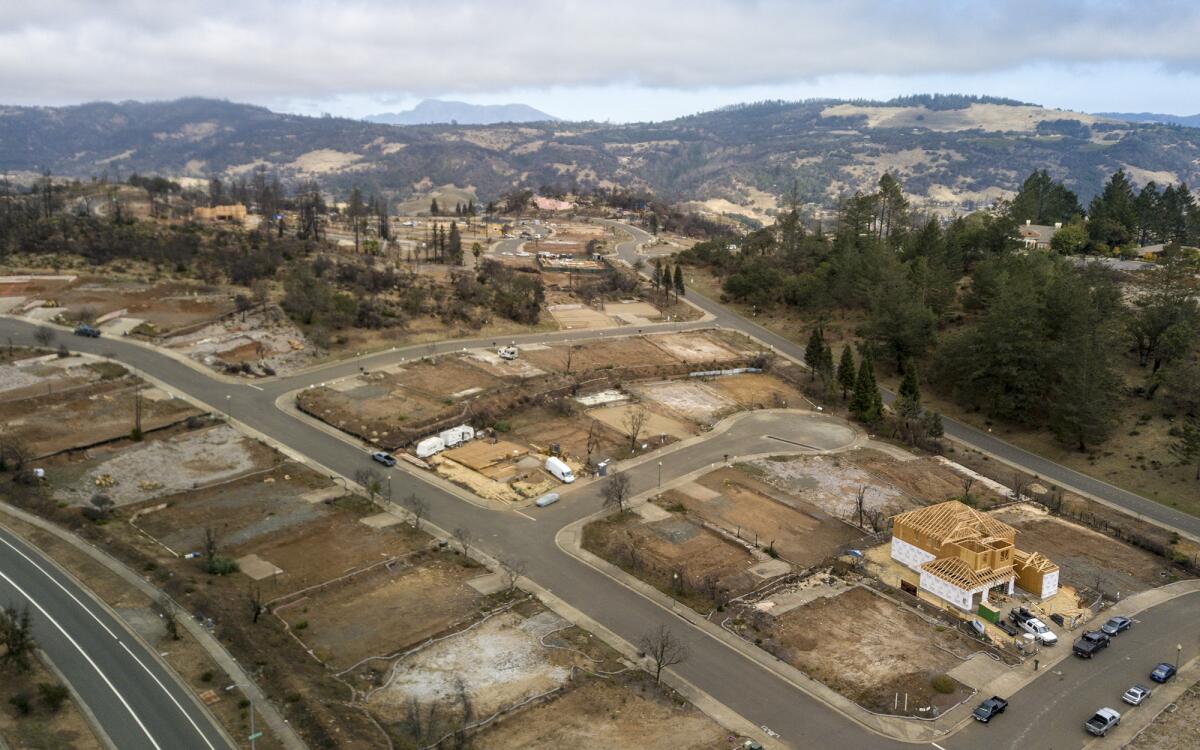Bill would force companies to keep insuring homeowners in wildfire zones. Will it work?

- Share via
Insurance companies fleeing high-risk fire zones would have to stay put and even offer discounts if homeowners in those areas prepare for wildfires on a community-wide scale, under a new bill proposed in Sacramento on Tuesday.
The bill, AB 2367, has the backing of state Insurance Commissioner Ricardo Lara. It would mandate that starting in 2021, insurers would have to renew policies and continue to write new ones in communities that meet state standards for firescaping, or home hardening, that would be established before the law takes effect.
“Homeowners who have done all the right things, hardening their homes and mitigating for fire danger, are still seeing their insurance canceled or non-renewed,” said state Assemblywoman Lorena Gonzalez (D-San Diego), co-author of the bill. “We can’t allow insurance companies to continue to drop responsible homeowners from San Diego to the Sierras just because they can.”
The bill is the latest move from Sacramento to force insurance companies to continue issuing policies in the state’s wildland-urban interface, the gray zone where millions of homeowners reside between suburbia and the forest. As of 2010, roughly one-third of the 13.6 million homes in California were located in this wildfire zone, according to federal data.
Since 2015, insurers have increasingly either boosted premiums or declined to renew homeowner policies in areas recently hit by wildfires or considered at high risk of experiencing one.
Assemblywoman Monique Limón (D-Santa Barbara), said that since the 2017 Thomas fire, homeowners in her district had experienced “unprecedented rates of insurance non-renewals even when the community has been working towards reducing the risk.”
Because of that, the bill’s proponents say, homeowners are finding it increasingly difficult to stay, rebuild or sell their home due to limited options.
“The key here in the long run is mitigation and how do we lessen the risk for homeowners, lessen the risk to the community,” Lara said. “What we’ve seen lately is consumers investing in thousands of dollars [in fire mitigation] without any guarantee they’ll get any coverage or that they won’t get dropped. This will get a fair balance: let’s get mitigation, inspections, then let’s guarantee you.”
Not everyone is convinced the bill is the best path forward. Rex Frazier, president of the Personal Insurance Federation of California, an association of state insurers, questioned the premise that community-wide efforts are sure to reduce the risks of home losses.
“We’re trying to figure out what is within the individual’s and the community’s power to stop property loss,” he said. “For wildfire, there’s no science right now that exists that can reliably predict what demonstrably reduces the risks of a homeowner. We’re not talking about ordinary home fires; we’re talking about mega-events. Even homes built to the 2008 standards in Paradise, only 50% of those homes survived.”
There are still a number of details to be worked out before the bill takes effect.
A task force that includes officials with the California Office of Emergency Services, State Fire Marshal, California Department of Forestry and Fire Management and the Governor’s Office of Planning and Research would need to come up with standards for home and community-wide firescaping, a method of maintaining land and property to reduce fire behavior and possible ignitions. The task force would consult with the insurance industry and the standards would differ depending on each community’s risks, Lara said.
Although there’s money in the budget to explore the issue, Lara said, it’s unclear ultimately who will be responsible for certifying that fire defense standards are met and then maintained. It’s also not clear how low-income or disabled residents would meet the standards if they cannot afford to do them or are physically unable to. The law would apply only to existing homes where there’s been an abrupt change in insurance availability, officials said.
Some experts see the legislation as a partial step in the right direction.
“The high-profile nature of the law makes it valuable in raising the profile of the issue,” said Lisa Dale, who teaches sustainable development at Columbia University’s Earth Institute. “It’s signaling a market-shift in these dynamics and it’s putting homeowners on notice that they’re going to be responsible for managing their own risk.”
That said, she added, “I’m very skeptical it will get us the outcomes we want.”
More to Read
Sign up for Essential California
The most important California stories and recommendations in your inbox every morning.
You may occasionally receive promotional content from the Los Angeles Times.











